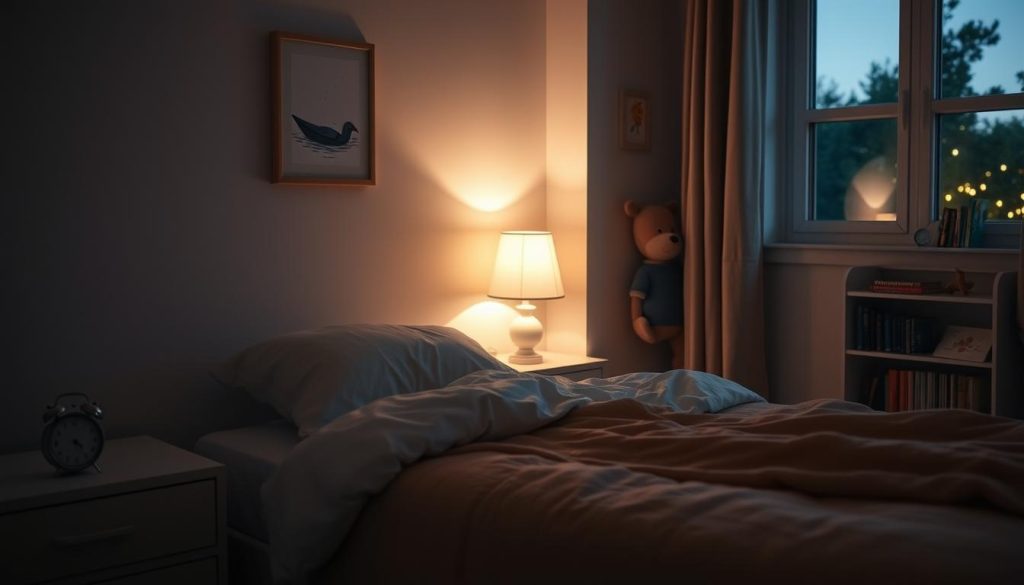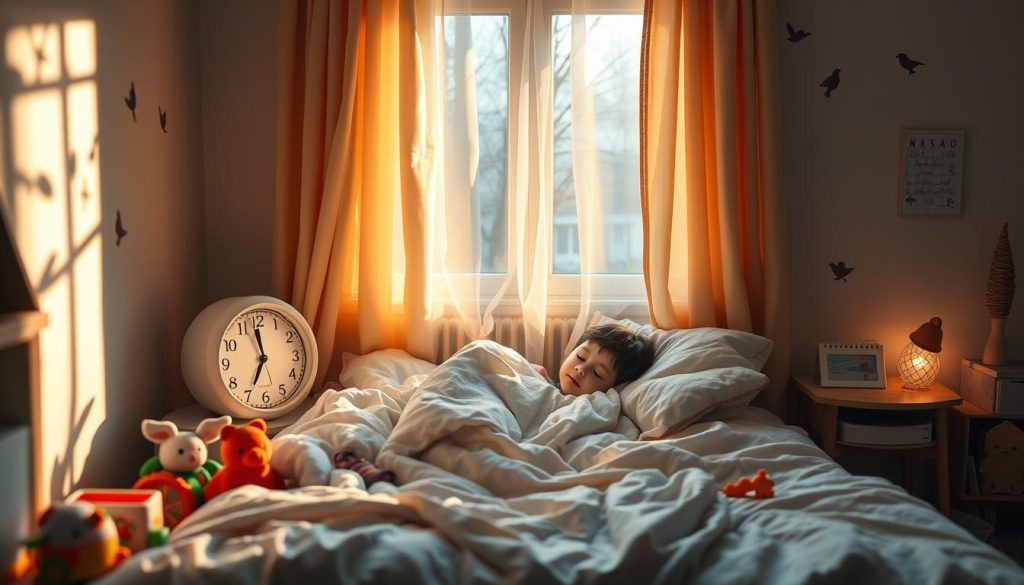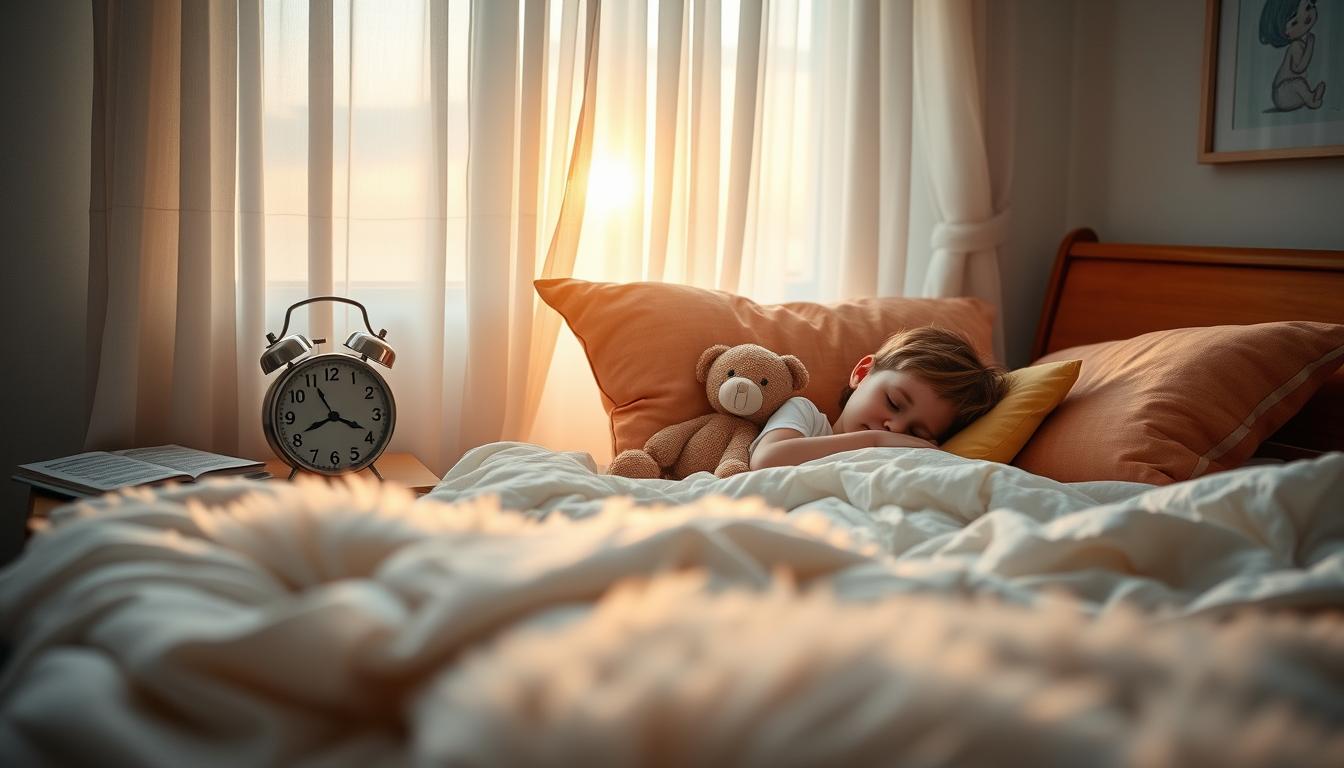Do early morning wake-ups ruin your peaceful mornings? Many parents struggle to keep their kids in bed longer. This is especially true for early risers who seem full of energy.
Could something as simple as a bedtime routine or a better sleep environment be the answer? Experts like Victoria Tenenbaum and “Miss Megan” say bedtime routines are key for good sleep. The American Academy of Pediatrics warns that not enough sleep can make kids irritable and harm their health.
The National Sleep Foundation gives important sleep guidelines. They say kids should avoid chocolate, sugar, and caffeine after 3 pm.
Parents like Tania from Boston and Sam from San Jose have found great solutions. They use things like blackout curtains and quiet bedtime activities. These strategies help create a sleep-friendly environment and avoid morning stimulation.
Key Takeaways
- Establishing a consistent bedtime routine can help children fall asleep faster and wake up less frequently.
- Optimizing the sleep environment with blackout curtains and white noise machines can encourage longer sleep.
- Avoiding stimulating foods and beverages like chocolate, sugar, and caffeine after 3 pm is crucial.
- Providing quiet bedtime activities, such as reading or listening to audiobooks, can help children wind down.
- Using gentle parenting techniques and avoiding punitive measures can foster better morning wake-up habits.
Establishing a Consistent Bedtime Routine
Creating a consistent bedtime routine is key for better sleep in kids. Many infants and toddlers struggle with sleep, a big worry for parents. A set routine helps kids know what to expect and learn to calm down, making mornings easier.
The Importance of Routine
For kids, especially those with stepchild issues or from divorced families, a stable bedtime routine is vital. Dr. Jodi Mindell says it makes them sleepy and sleep longer. It also lowers stress, makes them feel safe, and helps with middle child syndrome.

Steps to Create a Routine
Start the routine at 7:30 to 8 p.m. with calming activities. Here’s how to make a bedtime routine work:
- Choose pajamas
- Brush teeth
- Read a bedtime story
- Avoid screens and sugary snacks an hour before bed
Keep the routine short, about 15 minutes, to avoid too much excitement. Use white noise machines for a calm space. Watching how your child behaves at bedtime can help make the routine better for them.
Dealing with Resistance
Kids often resist new bedtime routines, especially with big changes like stepchild issues or divorce. Stick to it, even when they don’t want to. Most kids get used to it in a couple of weeks. If they still resist, online family therapy can offer help.
Putting time into a bedtime routine really helps sleep for both kids and parents. It not only improves sleep but also boosts mom’s mood and family harmony.
Optimizing the Sleep Environment
Creating a great sleep environment is key for kids’ well-being and growth. Make sure their sleep area is quiet and free from distractions. This helps them sleep better and longer.
Using Blackout Curtains and White Noise Machines
Blackout curtains can make a big difference in sleep quality. They keep the room dark, which is important for good sleep. Darkness helps make melatonin, a hormone that controls sleep.
White noise machines also help by blocking out loud noises. This makes sleep more peaceful. Victoria Tenenbaum says these tools worked well for kids like Tania from Boston, improving their sleep.

Removing Electronic Devices
It’s important to remove all electronic devices from the bedroom before bed. Too much screen time can make it hard to fall asleep and stay asleep. This is especially true for kids dealing with anxiety and eating disorders.
Quality sleep is vital for their health and well-being. So, it’s crucial to limit screen time before bed.
Creating a Calm and Quiet Space
To ensure a restful sleep environment, keep the room quiet and calm. Decluttering helps reduce distractions and creates a peaceful space. This is especially important for young children who are easily overwhelmed.
Following safety rules, like making sure cribs or beds are safe, is also important. Keeping the room at a cool temperature between 65-70°F helps too. By focusing on these areas, you can help your child sleep better and wake up less often.
Adjusting Daytime Activities to Promote Better Sleep
It’s important to balance your child’s daytime activities to help them sleep better. Changing nap times and activity levels based on their age can help. Miss Megan says using consistent awake times can stop them from waking up too early.

Managing Naps and Activity Levels
Managing naps and daily activities can greatly improve your child’s sleep. School-age kids need 9–12 hours of sleep, and teens need 8–10 hours. Liz Harden suggests avoiding naps that might mess up their nighttime sleep.
Appropriate Meal Timing
Mealtimes are also key. Eating too much or too little before bed can hurt sleep. A good evening meal helps prepare for a good night’s sleep. Avoid caffeine, especially in the evening.
Consistent routines are vital for sleep and overall health. These steps help create a balanced environment for your child’s sleep needs. By managing naps, staying active, and eating well, you’re setting them up for better sleep. This is good for their health and helps with postpartum mental health and social media safety.
Tackling Parenting Challenges in the Morning
Mornings can be tough for parents, especially with challenges like getting kids to transition and communicate. By using certain strategies, you can make mornings easier and less stressful. This helps your child grow and makes parenting smoother.
Introducing Quiet Time Activities
Quiet time activities are a great idea. Keep a basket of fun, age-appropriate activities near your child’s bed. This helps them learn to relax while still awake, reducing anxiety and giving you more time in the morning. Choosing eco-friendly toys for quiet time is a smart move.

Using Child-Friendly Alarm Clocks
Child-friendly alarm clocks are a big help in the morning. They show kids when it’s time to sleep and wake up. For example, a clock that changes color tells them when it’s okay to get up. This teaches them about time and routine, important as they get older.
Encouraging Self-soothing
Teaching kids to self-soothe is key to their independence. It makes mornings easier and prevents tantrums. This skill is also useful in sports, teaching kids to manage themselves.
By focusing on these strategies, you can tackle morning challenges. Quiet time, child-friendly clocks, and self-soothing make mornings better for everyone.
Conclusion
Creating a bedtime routine is key for your kids’ sleep and growth. It helps them feel secure and ready for the next day. This is especially true for families with sibling rivalry, as it helps everyone sleep better together.
A good sleep environment is also crucial. Using blackout curtains and white noise machines can help. Also, keep bedrooms quiet and free from screens to help your kids relax better. This is important for their emotional health and self-esteem.
Adjusting daytime activities can also improve sleep. Managing naps and meals helps control energy levels. Using quiet time or child-friendly alarm clocks in the morning helps kids feel more independent and sleep better.
The main point is to use different strategies to improve sleep and parenting. These methods, supported by experts and research, show how thoughtful parenting can change lives. They help overcome daily challenges and improve family life.
FAQ
How important is establishing a consistent bedtime routine?
What steps can I take to create an effective bedtime routine?
How can I deal with my child’s resistance to bedtime?
How can blackout curtains and white noise machines improve my child’s sleep environment?
Why is it important to remove electronic devices from my child’s bedroom?
How can I create a calm and quiet space for my child to sleep?
What are the best ways to manage naps and activity levels during the day?
How does appropriate meal timing affect my child’s sleep?
What are some tips for handling parenting challenges in the mornings?
How can quiet time activities benefit my child in the morning?
Are child-friendly alarm clocks effective for keeping kids in bed longer?
How can I encourage my child to self-soothe in the morning?
This post contains affiliate links. If you click on a link and make a purchase, I may earn a small commission — at no extra cost to you. Thank you for supporting this blog and helping me keep the patterns free! Read the full Affiliate Disclosure & Transparency.
